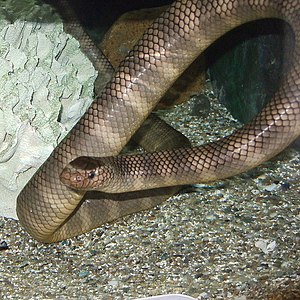Half-banded flattail
| Half-banded flattail | ||||||||||||
|---|---|---|---|---|---|---|---|---|---|---|---|---|

Half-banded flattail ( Laticauda semifasciata ) |
||||||||||||
| Systematics | ||||||||||||
|
||||||||||||
| Scientific name | ||||||||||||
| Laticauda semifasciata | ||||||||||||
| ( Reinwardt , 1837) |
The Halbgebänderte Plattschwanz ( Laticauda semifasciata , also known as Chinese Seeschlage or in Japan as Erabu umi hebi or Irabu known) is one within the family of poisonous snakes (Elapidae) and the subfamily of Laticaudinae the genus of laticauda ( Laticauda ). The species was first described scientifically in 1837 by the German natural scientist Kaspar Reinwardt . The species occurs exclusively in Asia in the warm western Pacific between Papua , Singapore and southern Japan such as Okinawa .
Appearance
The half-banded flattail has a rather short head with a relatively stocky trunk, the tail end consists mainly of skin, which is widened like a fin and has no firm support structure like a skeleton. The stomach is relatively large. Black and dark brown ribbons run along the body on the side, which led to the naming.
Way of life
The snake prefers to inhabit coral reefs near the coast and likes to breed in narrow crevices and caves. It shows a nocturnal way of life and is rarely found during the day. Since it breathes air, it comes to the surface at least every six hours. The flattail is too slow to pursue its preferred prey, the smaller fish, so it lurks hidden in the corals. Hunting groups of flat tails with other predators such as Mulloidichthys martinicus and Caranx melampygus have already been observed, which together drove prey fish out of narrow reef areas, comparable to the hunting strategies of some morays .
Reproduction and growth
Both sexes become reproductive from a body length of around 70–80 cm. Females lay their brood, usually consisting of 3–7 eggs, on land, where they hatch after another 4–5 months. When fully grown, they can reach lengths of up to 170 cm.
Poison
Half-banded flattails are extremely poisonous; theirs is about 10 times stronger than cobra venom . Attacks on humans are rare, however, as the snakes are shy and only bite when threatened. The poison, Erabutoxin B , acts on the nicotinic acetylcholine receptor in the muscles and paralyzes the prey.
Individual evidence
- ↑ Il-Hun Kim: Chinese sea snake (Laticauda semifasciata) misidentified as slender-necked sea snake in previous published account in Korea . In: Journal of Ecology and Environment . 2016, doi : 10.1186 / s41610-016-0002-3 ( biomedcentral.com ).
- ↑ Black-banded sea krait photo - Laticauda semifasciata - G78940 ( Memento of the original of October 8, 2012 in the Internet Archive ) Info: The archive link was automatically inserted and not yet checked. Please check the original and archive link according to the instructions and then remove this notice. In: ARKive.org , accessed July 17, 2016
- ↑ MC Tu: Reproductive biology of the sea snake, Laticauda semifasciata , in Taiwan . In: Journal of Herpetology . tape 24 , no. 2 , 1990, p. 119-126 , doi : 10.2307 / 1564218 , JSTOR : 1564218 ( jstor.org ).
- ^ Pseudolaticauda semifasciata In: Snakes of Taiwan , accessed October 7, 2012
- ↑ Erabutoxin B In: Uniprot.org , accessed on November 15, 2017